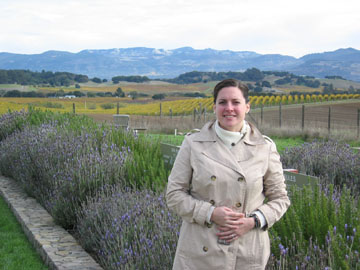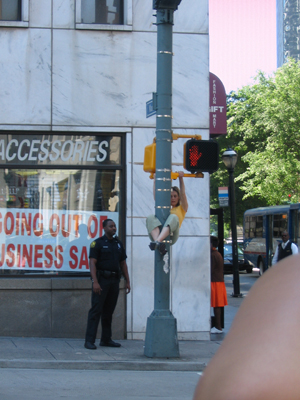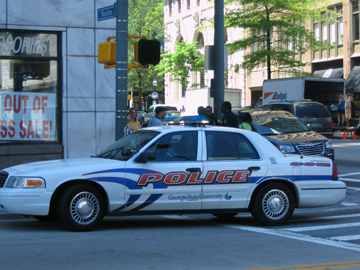Wrapping up my focus on Atlanta during my stint as guest blogger, I questioned Stuart Horodner, Artistic Director at the Atlanta Contemporary Art Center, and Lila Kanner, Executive Director of Artadia (and Art21 guest blog alum), about supporting Atlanta-based artists and the contemporary art scene here. Their responses are woven together in the following interview.

Stuart Horodner, Artistic Director, Atlanta Contemporary Art Center
Horodner has held director and curator positions at art centers and universities including the Atlanta College of Art Gallery, Portland Institute for Contemporary Art in Oregon, and Bucknell University Art Gallery in Lewisburg, Pennsylvania. He was the Founder and Co-Organizer of Affair at the Jupiter Hotel, an intimate art fair in Portland, OR between 2004-2007, and he was Co-Owner/Director of the Horodner Romley Gallery in New York City from 1992-97.

Lila Kanner, Executive Director, Artadia
Lila Kanner recently wrote about the first Artadia Atlanta Awards (Fahamu Pecou, interviewed in my last post, was a recipient). Prior to serving at Artadia, Kanner was the Associate Director of the Fabric Workshop and Museum, Philadelphia. From 1999 to 2002, she served as Director of Artist Services and Educational Programs at The Copley Society of Boston.
Victoria Lichtendorf: Stuart, you’ve spent time getting to know different art communities, most recently Portland, Oregon, prior to your work here in Atlanta. How would you describe the art community here compared with other cities? Have you found opportunities or challenges distinct to the area?
Stuart Horodner: Atlanta has a diverse arts ecology that operates in ways quite similar to several other cities, Portland among them. Often in these cities, there are a handful of good commercial galleries, university galleries, not-for-profit centers, community centers, artists collectives, festivals and such.
People in these cities struggle with several issues: limited criticism (one newspaper, one weekly paper) that cannot cover the various exhibitions and events sufficiently, and national art magazine coverage that rarely does more than the occasional review; the lack of significant numbers of dynamic and curious art collectors who seek out the dealers and venues for knowledge and access; limited patronage and city/state funding support; and the desire for larger and more diverse audiences.
These conditions are often frustrating to those professionals and practitioners on the ground, but the solution is found in vigilant cultivation, trying new things, contributing what you can, and producing excellence at all levels. In Atlanta, there are some of the same struggles—but that said, there are good and serious artists here who are showing locally and nationally, and there are a range of excellent and risk-taking commercial galleries. There is Atlanta Celebrates Photography (co-organized by Michael David Murphy) and Art Papers, helping to cultivate audiences. Universities and schools including Georgia State, Emory, Spellman, Agnes Scott, SCAD, and others offer solid programs in training young artists and historians. Exhibition venues including Eyedrum, MOCAGA, Spruill Art Center, Hammonds House, the Atlanta Contemporary Art Center, and The High Museum of Art all make significant contributions while pursuing their specific missions.
People tell me that this is the South and it takes time, and that there is general conservatism around contemporary art. My sense is that we simply need to continue to be bold and ambitious and find ways to make art play a major role in the civic, social, political, and economic power of this city.
VL: Lila, can you share some reasons why Atlanta was chosen as the latest city to benefit from Artadia’s presence? What is your impression of the local arts community? How does it compare with other Artadia sites?
Lila Kanner: Artadia’s Atlanta program was in the works for several years building up to the program launch in late 2008. Artadia chose Atlanta as a program city because of its vibrant arts community and diverse and very talented population of visual artists. As one of the fastest growing cities in the US, Atlanta has terrific support systems for artists and we also saw that we could play a role in providing an open application process, critical validation through our panel review, and unrestricted awards funds through a program that would be unique to the Atlanta landscape. We never want to duplicate existing programs and [therefore we] form partnerships in order to effectively and positively impact our partner communities. Artadia’s board and national donors support all the operating funds for the program, and all awards and program funds are raised locally. After conversations with many key stakeholders in the community from both foundations—among [them] collectors, local arts councils, museums, and artists—we found that there was a unique role our organization and program could play.

Nancy Popp, "Street Performance" (Downtown Atlanta), May 30, 2009. Photo by Victoria Lichtendorf.

Nancy Popp, "Street Performance" (Downtown Atlanta), May 30, 2009. Photo by Victoria Lichtendorf.
VL: Stuart, during performances I recently watched by artist Nancy Popp, I observed you and Managing Director Stacie Lindner acting as drivers, event coordinators, and camera crew. Last but not least, you negotiated with police riled by Popp’s climbing a streetlight in downtown Atlanta. What are the benefits in being part of a team where, truly, no task is too small?
SH: There are pros and cons to this “hands on” reality. Pros: passion and pride of accomplishment, nimbleness and collaborative spirit, and direct engagement with all levels of our institution’s mission in theory and practice. And it keeps you humble. We ask artists and board members and patrons to give a lot of themselves, and I think it helps to see that we will do anything necessary to accomplish our goals.
Cons: it can be exhausting and one fights against burnout. Limited staffing and working with tight budgets over time is a challenge for sure.

Stuart Horodner negotiating with state university police (city police are en route) after Popp performance in downtown Atlanta. Photo by Victoria Lichtendorf.
VL: While negotiating with the cops, you gave an ad hoc lesson in the history of performance art. What is the aim of the Contemporary in regards to outreach and education?
SH: Well, our outreach and education program does not usually include talking to police officers on the street. But that was lively. The Contemporary’s programs attempt to make contemporary art connect with people—so it can stimulate, engage, baffle, prod, and please their possible interests in visual culture, ideas, and discourse. And we try to make this happen with rigorous, generous, and accessible events including lectures, tours, panels, workshops, screenings, and trips. We try to facilitate and cultivate understanding and appreciation. And we are using any means necessary to do it—on site, virtual, social networking, Free Thursdays, etc.
As a professional curator/educator/critic, I have dedicated myself to trying to empower artists and audiences. The Contemporary has been doing this for 35 years.
VL: Lila, does Artadia have any particular interest in helping artists remain in their communities versus moving to bigger arenas?
LK: Artadia has a keen interest in helping artists remain in their communities. By providing opportunities for artists within their communities, bringing curators and arts professionals to Atlanta, and by spreading the word locally to build pride and sense of place as well as nationally that Atlanta is an important center for art and culture, we hope to nurture a buzz about the city that allows artists to continue to live and work in the metro area. Local awareness of the critical role visual artists play in civic life for the Atlanta metro area is also an important component of our work and ties into the our local and national work. We’ve forged important relationships with institutions and organizations including the Atlanta Contemporary Art Center and the Southern Arts Federation that also help further our work on behalf of artists locally to leverage opportunities for artists in Atlanta, and for Atlanta artists outside of the metro area.
VL: Following up on the same question I asked Lila, Stuart, what are your thoughts on helping artists remain in Atlanta, especially in regards to the Contemporary’s residential studio program?
SH: If artists have reasonably priced spaces to live and work, it certainly helps them stay in a city. We feel that providing 14 subsidized spaces and intimate access to programs and professionals is very significant. The health of the arts culture in the city plays a major role in terms of where people can thrive. Some people need to test themselves in the “big city” and interestingly enough, several excellent artists who left for grad school or jobs in New York are now moving back and bringing their experiences and contacts with them.
VL: According to the Contemporary’s history, the Atlanta Biennial began as a “tongue and cheek” response to the Whitney Biennial. How did it change in subsequent years? Are you still holding it?
SH: It changed by virtue of who curated it and what geographic condition it focused on—local curators, guest curators, only Atlanta, artists from all over the state. I selected the participants in the last version called Talent Show. It attempted to locate the notion of a biennial in the context of competitive reality TV shows like American Idol, Top Chef, etc. It was a very mixed bag by design—including seniors who do weekly art therapy classes, self-taught embroidery artists, very established names who show at fine galleries and complete unknowns who had never been in a show. I think it was an inclusive attempt and was somewhat critical of biennials while simultaneously being one! The most consistent response was that I should have simply picked the “best” artists working here and promoted them.
I think the local or regional biennial has run its course. I’m not so sure that inclusion in such a show really benefits the artists or the viewing public that much. And as you say, it was initially a response to local artists rarely getting selected for national high profile surveys. Why make a “tongue and cheek” concept into a habitual institutional given? Let’s think bigger and more creatively!
VL: Finally, I wanted to return to a topic I’ve been discussing over the past couple of weeks – the notion of regionalism. Julian Cox feels it’s a misunderstood and misused term, especially in relation to the High. What are your thoughts?
LK: This is a really interesting question and something I’ve spoken about a lot with Stuart and others recently. It is a privilege of my position to be part of six cities around the United States through our program and see what mechanisms each city has for artist support, engagement, learning, advocacy, discourse, exhibition, and collecting. There are differences at every level and each city is a delicate ecosystem. While there is terrific fluidity in style and no real ‘regional’ style, we do also see how various support mechanisms, economic realities, and mentors do impact the ways in which artists work across our program cities. Next year, Artadia is moving to a new publication format that will include artists from all five awards program cities in one book with more scholarly essays and content. In the past, we had produced a publication for each city which, though of great interest city by city, we believe the richer conversation is through a broader scope on the whole: Atlanta, Boston, Chicago, Houston, and the San Francisco Bay Area.
SH: I usually agree with Julian! It is a term that can be confusing and good or bad depending on who is talking and what they want. Do certain places have artists whose philosophies and methods (and successes) become dominant and shape perception over time? Yes. But there is always a bigger picture, and while we might cite Chicago and San Francisco and Houston as having specific figurative traditions that are distinct and were dominant in certain eras, that certainly was not the only kind of work being done then. Do certain art schools and influential teachers shape generational direction? Yes. Does market success sway certain trends? Yes. But there is always a flurry of activity that is on view, under the radar, adjusting to pressures from the local and beyond. And now, there is an “it’s all good” pluralism that pretty much defines everything and everywhere.
Maybe the economic crisis is new regionalism?




Pingback: The Contemporary « ART260